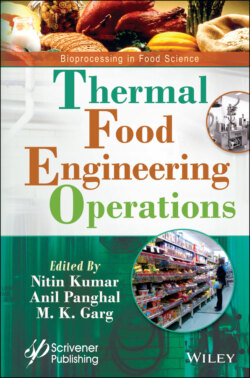Читать книгу Thermal Food Engineering Operations - NITIN KUMAR - Страница 17
1.2.3 Preservation Process
ОглавлениеThe basic definition of food indicates that food is the materials, formulated or processed which are consumed orally by living organisms for development, pleasure, needs, and fulfillment. The chemical composition of food includes majorly water, fats, lipids, and carbohydrates with less amount of minerals and compounds containing organics. The different categories of food are perishable, synthetic, non-perishable, fresh, medical food, harvested, manufactured, preserved, and others. The preservation of food majorly depends on the type of food required to be produced and formulated. Preservation of food is defined as maintaining its properties at the desired level for long as possible. Safety with sustainability and innovation are the major aspects and priorities to ensure the preservation of food. In the modern era, the preservation of and processing of food not only includes the safety of the foods but also maintains sustainable innovation, economic feasibility, customer satisfaction, nutritional aspects, absence of chemical preservative, and should be environmental sound [62].
Food preservation is necessary for ensuring desired quality level, consumer satisfaction, to maintain preservation length and also to focus on the group for whom the products are to be preserved [10]. The reason for preservation also includes to form the value-added products, provide modifications in diet, and most importantly to overcome the improper planning in agricultural sectors. Preservation loss not only results in minor deterioration of food but also results in the transformation of the food to a severely toxic state.
After a certain period of time, the quality and characteristics of food may get deteriorated and become undesirable for consumption so it becomes the prime factor to study the rate of variations of quality attributes which indicates its shelf life; this is a very important parameter to consider. The quality of products can rely on appearance, yield, eating characteristics, microbial characteristics, and the consumer’s overall experience. The deterioration of food depends upon mechanical, chemical, physical, and microbial reactions. The quality of the product was maintained at every stage of food production and overall processing chains such as manufacture, storage, distribution, and sale. Additionally, the need for preservation must depend on its purpose and use, and consider the population for whom the preservation is to be done as the nutritional requirement and food restriction apply differently to different sections of groups.
There are many measures for food preservation; inhibition, inactivation, and avoiding recontamination are the common ones. Each method contains several processes of preservation such as inhibition, which includes a decrease of oxygen, adding preservatives, control of pH, freezing, drying, surface coating, gas removal, fermentation, and many others. Inactivation includes irradiation, sterilization, extrusion, and others; avoiding contamination involves packaging, hygienic processing, aseptic processing, and others.
Thermal technology has been the backbone of food production and preservation for many years. In this technology, the temperature is assumed to be the major parameter for preservation and processing mechanism to make food commercially sterile, i.e., to get rid of pathogens and microorganisms which usually grow in the normal shelf life of the food product. Thermally processing the food provides real importance to the food by increasing and preserving its shelf life longer than the chilled food processing technologies.
In novel thermal technologies, preservation is done by the use of electricity. Various forms of electrical energy are utilized for food preservation such as ohmic heating, high intensity pulsed electric field, high-voltage arc discharge, microwave heating, and low electric field stimulation. Ohmic heating is the most common and is based on volumetric heating which prevents the overheating of food, provides uniform and quick heating; it depends on the principle that generation of heat in the food is an outcome of electrical residence when an electric current is moved through the food product. Furthermore, ohmic heating prevents thermal damage and promotes the efficiency of energy. Similarly, microwave heating is also very common and utilized in almost every household and the food industry but its low penetration depth of microwave into solid provides thermal non-uniformity. The other available methods utilizing electric energy are also very versatile, useful, and efficient for the preservation of food. The current electro heating can be used to produce to form new and up-to-date products with diversified functionality.
